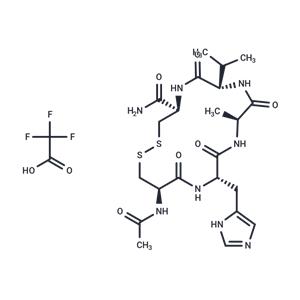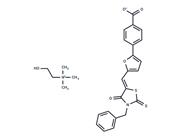| Name | ADH-1 trifluoroacetate |
| Description | ADH-1 trifluoroacetate (Exherin trifluoroacetate) is a cyclic pentapeptide vascular-targeting agent with potential antineoplastic and antiangiogenic activities. ADH-1 selectively and competitively binds to and blocks N-cadherin, which may result in disruption of tumor vasculature, inhibition of tumor cell growth, and the induction of tumor cell and endothelial cell apoptosis. |
| Animal Research | Exherin is prepared in PBS.Animals are anesthetized, and 40 μL of a single cell suspension containing 50,000 cells is injected into the pancreas. Mice are randomized into treatment groups 10 days after surgery. For treatment, mice are injected intraperitoneally once per day with Exherin at 50 mg/kg in 100 μL PBS (×1 per day, ×5 per week for 4 weeks). For in vivo bioluminescence, D-Luciferin is administered by intraperitoneal injection. Data are acquired 20 min after injection using the IVIS system. Tumor growth is monitored every 10 days from day 10 to day 50 after surgery. Luciferase activity is quantified using the IVIS system. Two months after surgery, the mice are killed, and the pancreas, liver, lung, and disseminated nodules are harvested, fixed in 10% buffered formalin, and embedded in paraffin. Serial 5-μM sections are cut, mounted on slides, and stained with H&E using standard procedures. |
| In vitro | In pancreatic cancer cells, Exherin (0.2 mg/mL) blocks collagen I-mediated changes and is highly potent at preventing cell motility induced by expression of N-cadherin. Exherin (0-1.0 mg/mL) dose-dependently induces apoptosis in a N-cadherin-dependent manner. |
| In vivo | In a mouse model for pancreatic cancer, ADH-1 (50 mg/kg) markedly inhibits tumor growth and metastasis [1]. In a rat aortic ring assay or antitumor potential in a PC3 subcutaneous xenograft tumor model, ADH-1 does not display either antiangiogenic activity [2]. The augmentation of melanoma tumor growth mediated by ADH-1 is not altered by regionally infused temozolomide. In A375, but not DM443 xenografts, ADH-1 can increase phosphorylation of AKT at serine 473. ADH-1 slightly diminishes N-cadherin expression in both xenografts[3]. |
| Storage | keep away from moisture | Powder: -20°C for 3 years | In solvent: -80°C for 1 year | Shipping with blue ice/Shipping at ambient temperature. |
| Solubility Information | DMSO : 43 mg/mL (62.8 mM), Sonication is recommended.
10% DMSO+40% PEG300+5% Tween 80+45% Saline : 2 mg/mL (2.92 mM), Sonication is recommended.
|
| Keywords | N-cadherin | Inhibitor | inhibit | Exherin Trifluoroacetate | ADH-1 Trifluoroacetate | ADH1 trifluoroacetate | ADH1 Trifluoroacetate | ADH-1 | ADH1 | ADH 1 Trifluoroacetate | ADH 1 trifluoroacetate | ADH 1 |
| Inhibitors Related | ADH-1 | Lycorine hydrochloride | ML327 | Cadherin Peptide, avian Acetate | PTA001_A4 |
| Related Compound Libraries | Failed Clinical Trials Compound Library | Bioactive Compound Library | Anti-Cancer Metabolism Compound Library | Anti-Cancer Clinical Compound Library | Drug Repurposing Compound Library | Inhibitor Library | NO PAINS Compound Library | Bioactive Compounds Library Max | Covalent Inhibitor Library | Anti-Cancer Compound Library | Anti-Cancer Active Compound Library | Anti-Cancer Drug Library |

 United States
United States






